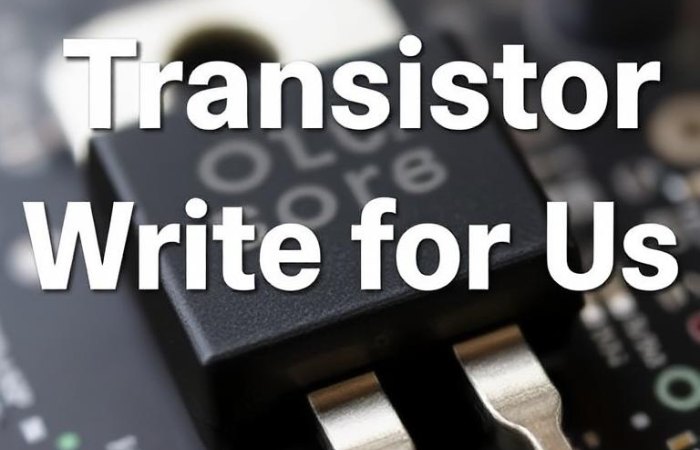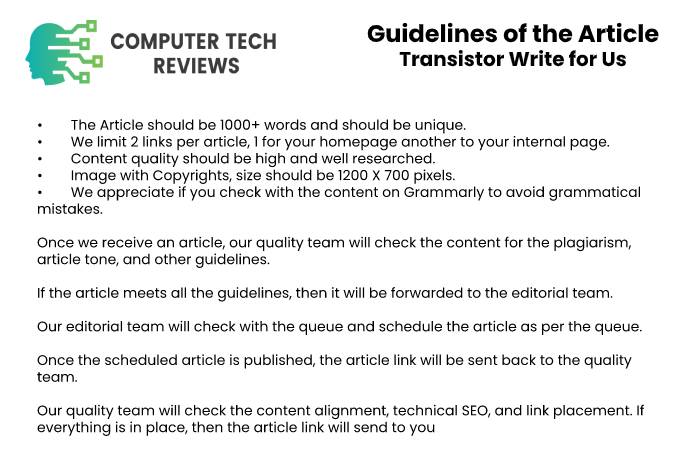Transistor Write for Us
 The transistor is an electronic component made of semiconductor materials that practically revolutionized all electronic devices without exception. Thanks to its small dimensions and multiple functionalities, it reduced all devices’ sizes considerably. Thanks to the transistors for the construction of integrated circuits that is, “Chips with an infinity of transistors capable of having various electrical and electronic circuits in plastic packages of only a few centimeters.”
The transistor is an electronic component made of semiconductor materials that practically revolutionized all electronic devices without exception. Thanks to its small dimensions and multiple functionalities, it reduced all devices’ sizes considerably. Thanks to the transistors for the construction of integrated circuits that is, “Chips with an infinity of transistors capable of having various electrical and electronic circuits in plastic packages of only a few centimeters.”
Parts of a transistor
The components consist of semiconductor crystals that, depending on their internal structure, can be referred to as material N or material P. In all transistors, two crystals of one material are always present and one of the other. For example, NPN or PNP, and each crystal corresponds to a terminal that is: emitter, base, and collector.
The emitter is responsible for providing the electrical charges, the base controls the flow of current, and finally, the collector collects the charges provided by the emitter. The difference in transistors’ uses is that we use NPNs for positive voltages and PNPs for negative voltages.
How does a transistor work?
Transistors have multiple functionalities and have two essential characteristics; correct polarization and its different operating regions.
Operating regions
Transistors have three operating regions, and each one does a different function, either as an open, closed, or amplifier switch. The utilization of these regions depends on the amount of voltage flowing through the transistor base.
Cutting region
The transistor enters the cut-off region when the base voltage is zero or less than 0.6v since it cannot activate the passage of current between the collector and the emitter; that is, it behaves like an open switch.
Saturation region
This region’s operation is the opposite of the cut-off. When the voltage that circulates through the base exceeds that established by the manufacturer, it saturates the transistor, which allows the circulation between collector and emitter as if it were a standard cable. In other words, it behaves like a closed switch.
Active region
This case happens when the base voltage is intermediate between the saturation region and the cut-off region. When we manage to stabilize the transistor, it can amplify the input signals as many times as it has the value of ß since it multiplies the transistor’s current.
To Write for Us, you can email us at contact@computertechreviews.com
Why Write for Computer Tech Reviews – Transistor Write for Us

Search Terms Related to Transistor Write for Us
Semiconductor
Device
Amplify
Switch
Electronic single
Electrical power
Material
Terminals
Connections
Circuit
Voltage
Output
Input
Field-effect
Mass products
MOSFET
Metal oxide
Radio
Calculator
Computer
Search Terms for Transistor Write for Us
writers wanted
write for us
guest post
contributor guidelines
looking for guest posts
become a guest blogger
guest posts wanted
guest posting guidelines
become an author
submit an article
guest posts wanted
submit post
suggest a post
write for us
guest post
contributor guidelines
contributing writer
Guidelines of the Article – Transistor Write for Us

You can send your article to contact@computertechreviews.com
Related Pages:
Big Data Write for Us
Software Write For Us
Cloud Computing Write For Us
Computer Write for Us
VOIP Write for Us
Data Center Write for Us
Web Design Write For Us
CCleaner Write For Us
SSD write for us
electronics write for us
iPad write for us
operating system write for us
accounting write for us
wireless write for us
virtual write for us
USB write for us
microphone write for us
streaming write for us
video promotion write for us
SQL write for us
Recent Posts
PRMovies: Stream Free TV Shows and Movies Online
PRMovies is one of the most famous sites for downloading free blockbuster movies. There are several other websites where you…
4 Must-Have Features of the Best PDF Redaction Software
Are you tired of spending hours manually redacting sensitive information from important documents? Look no further. The solution lies within…


